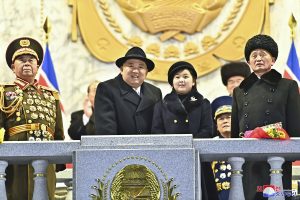On February 8, North Korea held a military parade to mark the 75th anniversary of the founding of the Korean People’s Army. The country’s Supreme Leader Kim Jong Un did not speak, but the parade was notable for showcasing a new type of intercontinental ballistic missile (ICBM) and “tactical nuclear operation units,” boasting to domestic and international audiences that North Korea’s five-year plan for the development of defense science and weapon systems, adopted at the 8th Congress of the Workers’ Party of Korea in January 2021, is moving steadily forward.
Since October 2020, North Korea has held its military parades either late at night or early in the morning, with media reports following. The parades are designed to enhance national prestige, with an elaborate show conveying to a beleaguered population that despite all the country’s economic difficulties, North Korea is still delivering in the military sphere.
Kim’s daughter, Kim Ju Ae, first appeared as the “beloved daughter” in November 2022. At the time, Rodong Sinmun spoke of Kim’s determination to perpetuate the regime, so it was thought that he wanted to make the people aware of the need for a powerful military to protect the children of the next generation. Later, she was also described as a “precious daughter.”
At this latest edition of the military parade, Kim Ju Ae was introduced as “respected daughter,” denoting a clear rise in rank. The modifier “respected” is unusual, and is not even used for Kim Jong Un’s sister, Deputy Department Director Kim Yo Jong. It is important to note that Kim Ju Ae is thought to be still only about 10 years old, and to bear in mind that in North policy can change at any time, depending on the will of the supreme leader. As such, it is too early to conclude that Kim is positioning his daughter is his successor. However, there is no doubt that the North Korean people see her as a very important person.
At the military parade, Kim Ju Ae stood together with her father in the center of the tiered platform, using chairs decorated in a way reminiscent of European royal families. There was much for observers to note. For instance, the chair she sat in was taller and more magnificent than that of First Lady Ri Sol Ju. Moreover, Kim Ju Ae was seated in the center at the anniversary banquet held the day before, with Kim Jong Un and Ri Sol Ju on either side of her.
It is hardly unusual for parents to have their children at their side, but if Kim Jong Un has more than one child, as is believed to be the case, it is unclear why his daughter is the only one to be making public appearances.
It is worth recalling that North Korea’s propaganda machine was already in full swing when it reported that Kim Jong Un was giving field guidance to military units in his mid-teens. Kim was just 24 years old when his father, Kim Jong Il, suddenly fell ill, but his early grooming as successor helped keep the family in power into the third generation. In that sense, if Kim does consider Kim Ju Ae to be his successor, then it is possible that he wants to take the time to entrench her position as “Empress” within North Korean society, which is marked by a deeply rooted, male-dominated Confucian culture.
What is concerning are the unconfirmed reports that she is Kim’s “second-born child.” The source for these reports is none other than the National Intelligence Service of South Korea, but there are many unanswered questions. For example, if the first-born child is confirmed to be a boy, why haven’t there even been any rumors, even about his name? Also, given reports that Kim actually has three children, then if his second-born child and daughter has been put in the limelight in order to keep his eldest child a secret, why hasn’t the third-born child been announced?
Even the name “Ju Ae” comes from former NBA star Dennis Rodman, to whom Kim Jong Un is to have directly introduced a girl called “Ju Ae” in September 2013. Given that Rodman is not a Korean speaker, we should consider the possibility that he might have misheard.
In North Korea, it is considered taboo to talk about the family of the supreme leader, so asking the country’s dignitaries will invariably be unhelpful.
For example, in an interview conducted by Japan’s Kyodo News on September 10, 2009, when the topic of who would succeed Kim Jong Il was attracting growing attention, it was reported that Kim Yong Nam, then president of the Presidium of the Supreme People’s Assembly, had said, “The issue of continuing the tradition of the revolution is important, but this is not related to the succession issue and is not discussed at this time.” It is now clear that preparatory work was underway at the time, and that with its quote Pyongyang was deliberating misleading with propaganda.
A year earlier, in September 2008, when Kim Jong Il was absent from the 60th anniversary of the country’s founding, theories about a serious illness ran rampant. At the time, Kyodo News reported Kim Yong Nam as saying that there is “no problem” with Kim Jong Il’s health. Deciphering the propaganda from Pyongyang is fundamental to North Korean analysis, and it should go without saying that it is dangerous to simply accept regime statements at face value, even more so when they concern especially sensitive themes such as the succession issue. What will be helpful going forward will be to see what modifiers are attached to Kim’s daughter, how often she appears in public, and whether songs praising her are released.

































